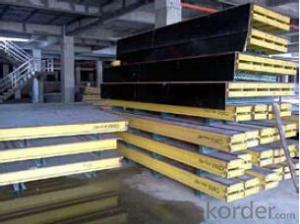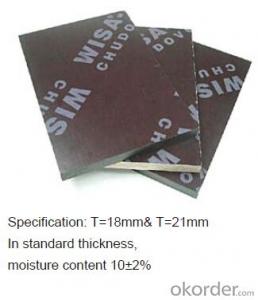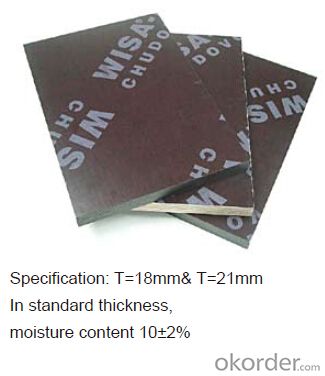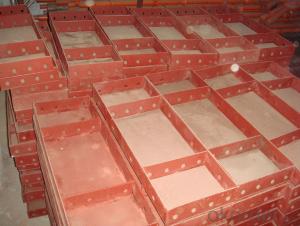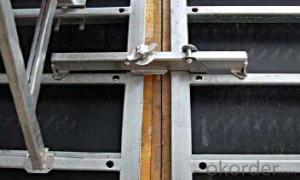Plywood-Formwork System for formwork and scaffolding
- Loading Port:
- Tianjin
- Payment Terms:
- TT OR LC
- Min Order Qty:
- 50 m²
- Supply Capability:
- 1000 m²/month
OKorder Service Pledge
Quality Product, Order Online Tracking, Timely Delivery
OKorder Financial Service
Credit Rating, Credit Services, Credit Purchasing
You Might Also Like
Plywood --- make perfect concrete surface
WISA-Form Birch is a coated special plywood using in the formwork systems where high
requirements are set on the concrete surface and the times of reuses.
With CNBM timber beam & WISA plywood, the formwork is low weight but high load capacity, it is
widely used in construction.
Characteristics:
◆ Component with high standardization.
◆ Assembling in site, flexible application.
◆ Light weight, easy transportation and storage.
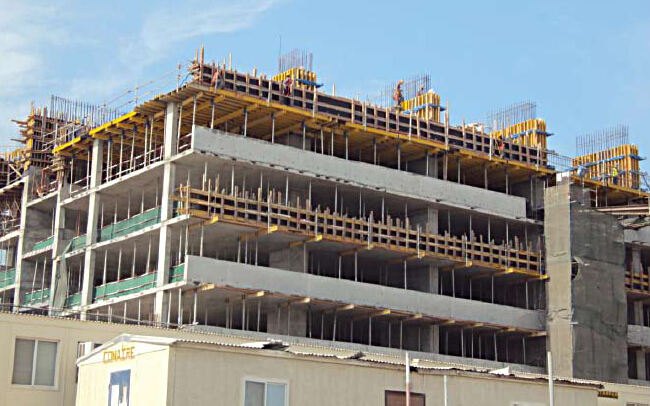
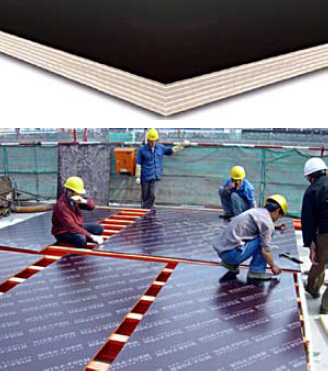
- Q: Can steel formwork be used for both small-scale and large-scale construction projects?
- Yes, steel formwork can be used for both small-scale and large-scale construction projects. Steel formwork is highly versatile and can be customized to meet the specific requirements of any construction project. It offers excellent durability and strength, making it suitable for withstanding the pressures exerted during large-scale projects. Additionally, steel formwork can be easily assembled and disassembled, allowing for efficient use on both small and large construction sites. Furthermore, steel formwork provides a smooth and consistent finish, ensuring high-quality results regardless of the scale of the project. Therefore, whether it is a small residential building or a large commercial complex, steel formwork can be effectively utilized to achieve the desired construction objectives.
- Q: How does steel formwork affect the quality of concrete?
- Steel formwork can have a significant impact on the quality of concrete in several ways. Firstly, steel formwork provides a rigid and stable structure that holds the concrete in place during the pouring and curing process. This ensures that the concrete maintains its desired shape and form, preventing any distortion or deformation. Secondly, steel formwork allows for precise and accurate construction of concrete structures. The smooth and even surface of steel formwork helps to create a uniform finish on the concrete, reducing the likelihood of surface imperfections such as air bubbles, honeycombing, or unevenness. This results in a higher quality and more aesthetically pleasing concrete finish. Furthermore, steel formwork offers better dimensional stability compared to other types of formwork materials. It is less susceptible to expansion or contraction due to temperature changes or moisture absorption, which can cause cracks or distortions in the concrete. This ensures that the structural integrity of the concrete remains intact, enhancing its overall quality and durability. Additionally, steel formwork provides excellent strength and load-bearing capacity. This allows for the construction of larger and more complex concrete structures with higher structural integrity. The sturdy nature of steel formwork ensures that the concrete can withstand heavy loads and external forces, reducing the risk of structural failures or collapses. Moreover, steel formwork is reusable, making it a cost-effective option in the long run. This not only contributes to sustainability but also ensures consistent quality in concrete construction. The ability to reuse steel formwork reduces the risk of formwork failure or deterioration that could affect the quality of subsequent concrete pours. In conclusion, steel formwork plays a crucial role in enhancing the quality of concrete. It provides stability, precision, dimensional stability, strength, and reusability, all of which contribute to the overall quality and durability of concrete structures.
- Q: How does steel formwork handle concrete shrinkage cracking?
- Concrete shrinkage cracking, which occurs as concrete dries and shrinks during curing, is specifically addressed by steel formwork. By minimizing and controlling these cracks, steel formwork plays a crucial role. During the curing process, steel formwork offers robust and rigid support to the concrete. It maintains the concrete's position, preventing any movement or shifting as it shrinks. This effectively restrains the development of large, uncontrolled cracks. Moreover, steel formwork withstands the high pressure exerted by the concrete during curing. This ensures that the formwork remains intact and free from deformation or breakage, thereby averting any cracks in the concrete. Furthermore, steel formwork allows for the incorporation of expansion joints. These joints are strategically positioned within the formwork to accommodate the anticipated shrinkage of the concrete. By providing controlled spaces for the concrete to shrink into, the formation of random cracks is minimized. Additionally, steel formwork offers the advantage of easy inspection for any cracks that might have occurred during curing. This enables early detection and repair of potential issues, preventing further cracking or damage to the concrete structure. In conclusion, steel formwork effectively addresses concrete shrinkage cracking through its strong support, resistance to pressure, provision of expansion joints, and facilitation of inspection and repair.
- Q: How does steel formwork affect the overall constructability of the structure?
- The overall constructability of a structure is greatly enhanced by the use of steel formwork. Firstly, the high strength and durability of steel formwork enable it to withstand the pressure and forces exerted during the concrete pouring and curing process. This strength allows for the construction of taller and more complex structures, providing greater design flexibility. Furthermore, the reusability of steel formwork significantly reduces construction time and costs. Unlike traditional wooden formwork, steel formwork can be easily dismantled, cleaned, and reassembled for future concrete pours. This eliminates the need for continuous formwork fabrication, resulting in faster construction cycles and increased productivity. In addition, steel formwork ensures excellent dimensional accuracy and stability. The rigid structure of steel formwork allows for precise pouring and shaping of concrete according to desired dimensions, resulting in a more accurate and seamless end product. This accuracy is particularly important for high-quality construction, especially in critical elements such as walls, columns, and beams. Moreover, steel formwork offers superior surface finishes and better concrete quality. Its smooth and non-absorbent surface prevents water leakage or seepage from the concrete, resulting in a higher-quality finish. This is particularly beneficial for structures that require high aesthetic appeal or exposed concrete surfaces. Lastly, steel formwork enhances safety on construction sites. Its robust structure and stability reduce the risk of accidents during the concrete pouring and formwork removal processes. Steel formwork also allows for easier access and movement of workers, ensuring safe and efficient task performance. In conclusion, steel formwork significantly improves the constructability of structures. Its strength, reusability, dimensional accuracy, surface finish, and safety benefits make it a preferred choice for construction projects. By utilizing steel formwork, construction processes become more efficient, cost-effective, and reliable, resulting in a higher-quality end product.
- Q: I was engaged in the patent agency, the two days of receipt of a patent application on the bridge, it is a drawing section map, the other nothing, no label no text, I am on mechanical, civil engineering drawings and utterly ignorant of ah, so simple, later on the Internet for a long time and recall ratio of patent it is unclear whether the drawings, sections of the box girder template, now the goal is clear, but a box girder template knowledge I don't know much about the Internet, did not find out what things, patent is only a few patents, I want to know more about the box girder and box girder template for example, the box girder template with cast-in-place prefabricated, full steel structure, steel wood structure, the hydraulic support system, but also ordinary (the ordinary I don't know what), etc. So, anyway, more detailed information as possible, thank you ~ ~ no more, I don't mind ah, not much, have a point with the province oh
- I am specialized in Civil Engineering (design and construction), you see the drawings are box girder template for the design of template
- Q: How does steel formwork affect the overall dimensional stability of a structure?
- The overall dimensional stability of a structure can be significantly improved by using steel formwork. Steel formwork is known for its strength and rigidity, which makes it an excellent support system during construction. This ensures that the concrete is accurately and precisely placed, resulting in a structure with enhanced dimensional stability. There are several advantages to using steel formwork that contribute to its overall dimensional stability. Firstly, steel has a high strength-to-weight ratio, allowing for the creation of strong and durable formwork systems. This strength prevents any shifts or movements in the formwork during concrete pouring, reducing the likelihood of dimensional changes in the final structure. Furthermore, steel formwork offers superior dimensional accuracy compared to other materials. The steel plates or panels used in the formwork can be manufactured with high precision, resulting in consistent dimensions and smooth surfaces. This eliminates any inconsistencies or irregularities that may occur with traditional formwork materials like wood or plywood, further enhancing the overall dimensional stability. In addition, steel formwork is highly resistant to moisture, humidity, and temperature variations, which can cause dimensional changes in other materials. This resistance ensures that the formwork remains stable and maintains its original shape, even in challenging environmental conditions. The stability extends to the concrete poured within the formwork, as the steel helps to minimize shrinkage and expansion, reducing the risk of cracks or warping in the structure. In conclusion, steel formwork is essential for maintaining the overall dimensional stability of a structure. Its strength, precision, and resistance to environmental factors ensure that the formwork remains intact and accurately supports the concrete placement. By providing a reliable and robust framework, steel formwork allows for the creation of structures with enhanced dimensional stability, resulting in a long-lasting and durable final product.
- Q: What are the safety precautions when using steel formwork?
- When using steel formwork, there are several important safety precautions that should be followed to ensure the well-being of workers and the successful completion of the project. 1. Adequate training and awareness: All workers involved in using steel formwork should be properly trained on its safe handling and usage. They should be aware of the potential hazards and the correct procedures to follow. 2. Inspection and maintenance: Before using steel formwork, it is essential to inspect it thoroughly for any defects or damage. Any damaged or weakened parts should be repaired or replaced before use. Regular maintenance should be carried out to ensure the formwork remains in good condition. 3. Proper handling and storage: Steel formwork can be heavy and require multiple workers for handling. It is important to use appropriate lifting and handling equipment, such as cranes or forklifts, to avoid strain or injuries. When storing the formwork, it should be secured properly to prevent it from falling or causing accidents. 4. Fall protection: When working at heights with steel formwork, fall protection measures such as guardrails, safety nets, or personal fall arrest systems should be implemented. Workers should be provided with proper safety harnesses and trained on their usage. 5. Secure installation: Steel formwork should be securely installed to prevent collapse or movement during concrete pouring or other construction activities. It is crucial to follow the manufacturer's instructions and use appropriate bracing and support systems to ensure stability. 6. Adequate signage and barriers: Proper signage and barriers should be placed around the work area to warn others of potential hazards and restrict access to authorized personnel only. This helps in preventing accidents and keeping unauthorized individuals away from the construction site. 7. Personal protective equipment (PPE): All workers involved in using steel formwork should wear appropriate PPE, including hard hats, safety boots, gloves, and eye protection. This protects them from potential injuries caused by falling objects, sharp edges, or other hazards. 8. Regular communication and coordination: Effective communication and coordination among workers using steel formwork are crucial to maintain a safe working environment. Clear instructions, regular safety meetings, and the availability of emergency procedures ensure everyone is aware of their roles and responsibilities. By following these safety precautions, the risks associated with using steel formwork can be minimized, and a safe working environment can be maintained for all workers involved in the construction project.
- Q: Is steel formwork suitable for projects with high concrete temperature requirements?
- Steel formwork is generally not considered suitable for projects with high concrete temperature requirements. This is because steel has a high thermal conductivity, meaning it can rapidly transfer and dissipate heat. When exposed to high concrete temperatures, steel formwork can become extremely hot, potentially leading to deformation, warping, or even failure. In contrast, materials with lower thermal conductivity, such as timber or plastic formwork, are better suited for projects with high concrete temperature requirements. These materials provide better insulation and can handle the increased heat without compromising their structural integrity. However, it's important to note that there are certain types of steel formwork that are specifically designed to withstand higher concrete temperatures. These specialized formwork systems are typically made from heat-resistant alloys or have additional insulation layers to minimize the impact of temperature on the steel. Ultimately, the suitability of steel formwork for projects with high concrete temperature requirements depends on the specific type of steel formwork being used and its ability to withstand and dissipate heat effectively. It is recommended to consult with structural engineers and formwork suppliers to determine the most appropriate formwork material for such projects.
- Q: Are there any specific design considerations for steel formwork systems?
- Yes, there are several specific design considerations for steel formwork systems. These include factors such as the load-bearing capacity of the system, its stability and rigidity, ease of assembly and disassembly, durability, corrosion resistance, and adaptability to different project requirements. Additionally, the design should incorporate safety features like non-slip surfaces, secure connections, and proper bracing to ensure worker safety during construction activities.
- Q: What are the advantages of using steel formwork?
- There are several advantages of using steel formwork. Firstly, steel formwork is highly durable and can withstand multiple uses, making it cost-effective in the long run. Secondly, it provides a smooth and consistent finish to the concrete structure, resulting in high-quality construction. Additionally, steel formwork is lightweight and easy to handle, which reduces labor and transportation costs. It also offers flexibility in terms of design modifications and can be easily assembled and dismantled. Lastly, steel formwork is fire-resistant and offers better safety measures compared to other formwork materials.
Send your message to us
Plywood-Formwork System for formwork and scaffolding
- Loading Port:
- Tianjin
- Payment Terms:
- TT OR LC
- Min Order Qty:
- 50 m²
- Supply Capability:
- 1000 m²/month
OKorder Service Pledge
Quality Product, Order Online Tracking, Timely Delivery
OKorder Financial Service
Credit Rating, Credit Services, Credit Purchasing
Similar products
Hot products
Hot Searches
Related keywords
